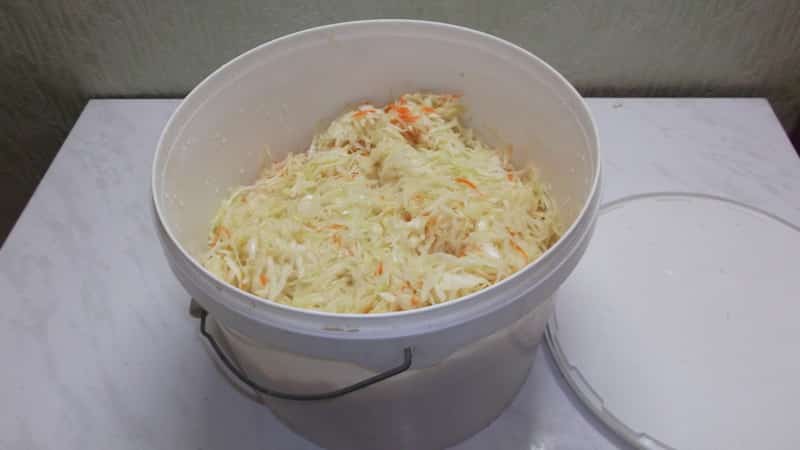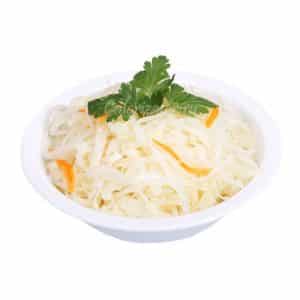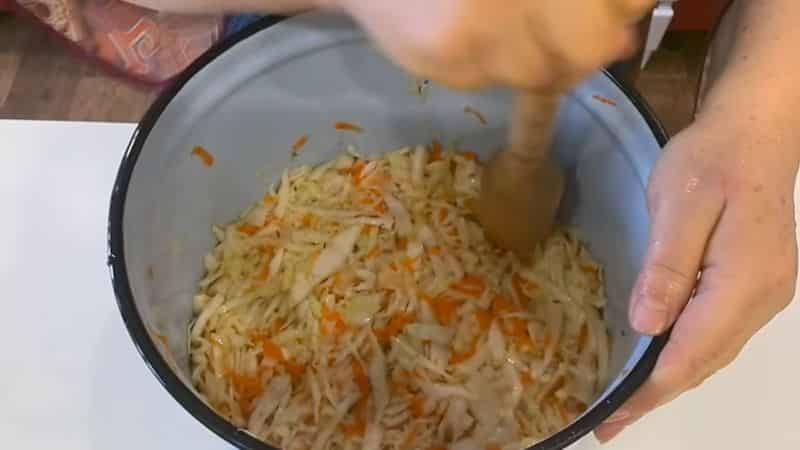Step-by-step recipes for the winter: how to properly ferment cabbage in a bucket
Sauerkraut is one of the healthiest and most delicious snacks. After all, when fermented, the vegetable not only retains all its vitamins, but also becomes even more useful. This winter preparation contains a lot of vitamin C and has a positive effect on digestion. It goes well with meat and main courses, and is used as an ingredient in soups and pies.
Many housewives try to ferment more cabbage so that they can later use it as needed. It is more convenient to cook large portions in a bucket. Read on to learn how to pickle cabbage in buckets for the winter.
Features of sauerkraut in a bucket

Many housewives prefer to ferment cabbage according to the classic recipe in a bucket. This allows you to prepare snacks in large portions. Moreover, a bucket takes up much less space than a basin or barrel. It is much more convenient to install pressure on a bucket.
Only enamel buckets are suitable for fermenting vegetables. They do not affect the taste of products in any way and do not emit harmful substances.
It is not recommended to ferment cabbage in plastic containers. The acid released during the cooking process of the vegetable reacts with the polymers and causes chemical reactions. This leads to the release of compounds that negatively affect the body.
Containers made of stainless steel and other metals are also not used. Sour cabbage juice oxidizes the metal, which leads to a change in the taste of the snack for the worse.
In addition to a bucket, you will need some pressure to ferment the cabbage.A rock or a water bottle will do. Weights and other metal objects should not be used, as juice that gets on them will lead to oxidation of the material.
It is difficult to unequivocally answer the question of how long cabbage ferments at room temperature in a bucket. This process usually takes from 4 to 8 days. It all depends on the products chosen and the recipe used for pickling.
To prepare delicious sauerkraut, consider some nuances:
- During the fermentation process of cabbage, gases are formed. They are released by piercing the mixture of chopped vegetables daily in different places to the full depth. If you don’t do this, the snack will turn out sour or bitter.
- To understand that the fermentation process is going correctly, look closely at the surface of the lettuce. If foam or bubbles appear on top, then all cooking conditions have been met.
- During the fermentation process, vegetables release juice. The cooking process ends when virtually no liquid is released.
- Before stopping the fermentation process, the salad is tasted. If it is not sour enough, then it is left in a warm place for another 1-2 days, even if the time for sourdough specified in the recipe has expired.
- The readiness of cabbage is determined by its color. The fermented product has a yellowish or pale orange tint.
- It is believed that the most delicious appetizer is fermented during the waxing moon.
- During hot periods, winter cabbage salad is not prepared. The best time is the first frost.
In a cool place, the cabbage will also ferment, but then it will not be as crispy, and it will take more than 2 weeks to prepare.
Preparing Ingredients
The quality of sauerkraut largely depends on the correct selection and preparation of ingredients. Before fermenting, all vegetables and fruits are washed and cleaned of dirt and seeds.
Containers and pressure are also washed. Some housewives recommend pouring boiling water over the container.
Do not use spoiled products for pickling. All ingredients must be strong, without traces of rot, mold or disease. Fruits with damaged parts cut off are not suitable for this dish.
Cabbage selection
The taste of sauerkraut in a bucket depends not only on the recipe, but also on the main ingredient. If you choose the wrong head of cabbage, the snack will turn out soft and sour:
- Color. For pickling, choose white varieties of cabbage. The color should be as uniform as possible. Loose green heads of cabbage will not work.
- Variety Late varieties of vegetables are best suited for pickling. It is these heads of cabbage that will turn out crispy and will be stored for a long time. The leaves of late cabbage are coarse and tough, but when fermented they soften, becoming more tender without losing their crunch. Mid-season varieties are also suitable, but they will be stored for less time and will not be as crispy.
- Dimensions. It is more profitable to choose large heads of cabbage, since the core of all cabbage is approximately the same size. Large heads of cabbage will have many more leaves.
- Quality. It is important that the cabbage is not frozen. If the top leaves on the heads of cabbage have a greenish tint, then the vegetable is suitable for pickling. If they are snow-white, the top leaves were damaged, and the seller cut them off. The selected head of cabbage must be dense, without damage, signs of disease, mold or rot.
Other Supplements
A number of other ingredients are used to ferment cabbage.
Salt To prepare a winter snack, it should be ordinary table food (coarsely ground). Iodized seasoning will cause the vegetables to soften and become less crunchy.It is easy to over-salt the workpiece with fine salt.
To ensure that the cabbage is crispy, ingredients containing tannins are added to it. Usually oak leaves or horseradish are used. Such additives change the taste of the snack (usually for the better).
In most cases, in addition to cabbage, carrots are added to the appetizer. It gives a pleasant sweetish taste and a beautiful light orange color.
This salad is combined with various fruits and berries. Often added to salads cranberries, apples, plums, lingonberries, pepper, dill.
Cooking recipes

There are many recipes for making sauerkraut. Some of them contain minimal ingredients and have a classic taste, while others contain unexpected additives and have an unusual aroma.
Classic recipe with cranberries

Sauerkraut for the winter in a bucket according to the classic recipe with cranberries turns out tasty and unusual. The sour taste of the salad goes well with the tart berry aroma. In addition, cranberries contain benzoic acid, which extends the shelf life of the product.
Ingredients:
- cabbage – 5 kg;
- salt – 100 g;
- cranberries - 200 g;
- carrots – 200 g.
This amount of ingredients is enough for a 5 liter bucket. To ferment a 10 liter bucket of vegetables, the amount of products is doubled.
Here's how to ferment cabbage and cranberries in a bucket for the winter:
- The cabbage is washed and the top leaves are removed. The stalk is cut from the head of cabbage. After this, the cabbage leaves are shredded, cutting them into thin long sticks.
- The carrots are peeled, washed and chopped on a coarse grater.
- In a separate container, mix carrots, cabbage and salt. When mixing, crush the vegetables with your hands so that the juice is released and the ingredients absorb the salt. The resulting mass is divided into 4 parts.
- Place clean cabbage leaves at the bottom of the bucket.Then add ¼ of the cabbage-carrot mixture and compact it thoroughly.
- The cranberries are washed and separated from the branches. All rotten or limp berries are removed.
- A third of the berries are poured into a bucket. Spread ¼ of the cabbage mixture over the berries. This layer is also carefully compacted.
- The ingredients are alternated in this way until they are all in the bucket. There should be a cabbage layer on top.
- A wooden round stand or plate is placed on top of the vegetables, on which a load is placed.
In this recipe, cranberries can be replaced with lingonberries or viburnum.
With apples

This is an old Russian way of pickling cabbage. Apples retain vitamins with this method of harvesting for the winter. Both ingredients acquire an unusual tart fruity taste that goes perfectly with any hot dishes.
Ingredients:
- apples – 1 kg;
- salt – 6 tbsp. l.;
- cabbage – 5 kg;
- large carrots - 2 pcs.
Only green apples are suitable for this recipe. It is best to use Antonovka.
Step-by-step recipe for fermenting cabbage with apples:
- The cabbage is washed and cut into strips. The carrots are peeled and chopped on a coarse grater.
- Vegetables are mixed on the table. Salt is added to them. The ingredients are crushed by hand to release the juice.
- Apples are cut into quarters. Clean the tails and cut out the core.
- Mix with cabbage in a separate container. The mixture is placed in a bucket and compacted.
- Cover the top of the salad with a lid and put pressure on it. Leave the cabbage at room temperature for 48 hours.
Dry fermentation
The dry method of sauerkraut is the most common. This cooking option does not involve the use of brine. This allows the salad to be stored longer.
Ingredients:
- cabbage – 10 kg;
- carrots – 1 kg;
- salt – 10-12 tbsp. l.
Ferment the salad at room temperature.
How to salt cabbage in a simple dry way:
- The cabbage is chopped into thin strips. The carrots are peeled and chopped on a coarse grater.
- The ingredients are mixed on the table. Salt is added to them. Crush the vegetables with your hands, mixing them with salt until the juice comes out.
- The salad is moved into a bucket, compacted. Place a lid and pressure on top.
The more firmly the cabbage is compacted into the bucket, the crispier the salad will be. Neglecting pressure will make the salad soft and without a characteristic crunch.
Advice! Some housewives grate carrots for Korean salads. This makes the snack look more beautiful.
Whole heads of cabbage
The most ancient method is considered to be sauerkraut with whole heads of cabbage. Previously, it was salted in a barrel, but now a bucket is used for this.
Ingredients:
- cabbage heads – 10 kg;
- salt – 400 g;
- water – 10 l.
For this recipe, small, strong heads of cabbage without traces of mold, rot or other damage are suitable. It is important to know the origin of the vegetables, since in this recipe the stalk, which often contains nitrates, is not removed.
Here's how to pickle whole heads of cabbage:
- The forks are washed and cleared of the top green leaves. If desired, cut them into halves or quarters.
- The bottom of the bucket is covered with cabbage leaves. Then the heads of cabbage are laid. They are covered with leaves on top.
- Prepare the brine. To do this, salt is dissolved in warm water. Wait for the brine to cool, then pour it into a bucket with heads of cabbage.
- The cabbage is covered with a lid or a round wooden stand. Oppression is installed on top.
Some housewives add grated carrots or lingonberries and cranberries to a bucket of cabbage heads. An assortment of shredded and whole cabbage is prepared.
Important! When using this recipe, the heads of cabbage will have to stand indoors for at least 5 days.
Cold sourdough method with saline solution

Some housewives believe that it is easiest to ferment cabbage in brine. In this case, it turns out crispier, but is stored less.
Ingredients:
- water – 5 l;
- cabbage – 10 kg;
- salt – 15 tbsp. l.;
- sugar – 10 tbsp. l.;
- allspice – 1 tbsp. l.;
- carrots – 4 pcs.;
- dill seeds – 1 tbsp. l.
Allspice and dill are added as desired. If the taste of these spices is unpleasant, do without them.
Cooking method:
- Shred the cabbage thinly. The carrots are peeled and chopped on a coarse grater.
- Vegetables are mixed in a large basin. Add allspice and dill seeds.
- All ingredients are mixed and mashed until juice comes out.
- Prepare a brine from warm water, sugar and salt. The mixture is stirred until completely dissolved.
- After the brine has cooled, it is poured into the salad. The liquid should completely cover the vegetables.
- Place a lid or circle on the salad and apply pressure.
The cabbage will be ready in 3 days. Store it in brine.
With horseradish root
The combination of cabbage and horseradish is unusual. It will appeal to lovers of savory notes in classic dishes. Horseradish will allow the salad to be stored longer.
Ingredients:
- salt – 10 tbsp. l.;
- sugar – 400 g;
- water – 7.5 l;
- bay leaf – 15 pcs.;
- horseradish root – 0.5 kg;
- carrots – 1 kg;
- black peppercorns – 30 pcs.
This recipe involves fermenting vegetables in brine. The dry method is not suitable in this case.
Recipe for sauerkraut with horseradish:
- The cabbage is peeled from the outer leaves and thinly shredded. Carrots and horseradish are peeled, washed and grated.
- The vegetables are mixed. Peppercorns and bay leaves are added to them.
- Prepare the brine. To do this, add salt and sugar to the water. The brine is stirred until the salt is completely dissolved.
- Sweet and salty brine is poured over the salad. The bucket is covered with a lid.
In this recipe, the use of pressure is optional. The appetizer will be ready in 3-4 days.
Pickled in brine
You don't have to wait several days for it to cook to try sauerkraut. The popular crispy snack is cooked in hot brine in just a few hours.
Ingredients:
- cabbage – 10 kg;
- water – 10 l;
- carrots – 2 kg;
- garlic – 6 heads;
- salt – 20 tbsp. l.;
- sugar – 2 kg;
- vinegar – 800 ml.
This snack will keep for several weeks. Housewives believe that the longer it sits, the tastier it becomes.
How to cook cabbage appetizer in hot brine:
- Shred the cabbage thinly. The carrots are washed, peeled and chopped on a coarse grater.
- Cabbage and carrots are mixed. Finely chopped garlic is added to the vegetables.
- Prepare the brine. To do this, sugar and salt are added to the water. The mixture is brought to a boil, after which vinegar is poured into it.
- The salad is allowed to stand on the table for 2 hours, after which it is put in the refrigerator. The next day the salad will be ready.
Sauerkraut with tomatoes, peppers and zucchini
The pickled vegetable assortment turns out tasty and unusual. This is a real salad that does not need to be supplemented with other ingredients. Just pour oil into the appetizer and serve.
Ingredients:
- cabbage – 7 kg;
- tomatoes – 1 kg;
- pepper – 1 kg;
- carrots – 4 kg;
- zucchini – 1 kg;
- greens - a bunch;
- garlic – 2 heads;
- water – 10 l;
- salt – 20 tbsp. l.
Those who don't like garlic can omit it from the recipe.
Method for preparing cabbage salad with peppers, tomatoes and zucchini:
- Shred the cabbage thinly. The carrots are chopped on a coarse grater. Zucchini - grated for Korean carrots. Peppers are cut into thin strips. Tomatoes are peeled from seeds and cut into half rings.
- The vegetables are mixed. Chopped herbs and garlic are added to them.
- Salt is dissolved in water. The resulting brine is poured over the vegetables. They put oppression on top.
Rules for storing workpieces

Sauerkraut can be stored all winter. It is placed in the basement or refrigerator. To prevent mold from appearing, mustard plasters are placed on top.
It is not necessary to store the snack in the bucket in which it was fermented. For convenience, it is laid out in smaller glass or enamel containers. Salad cannot be stored in plastic.
Conclusion
Sauerkraut is an old Russian dish. It is incredibly healthy and is considered one of the main sources of vitamin C and other microelements.
It is not difficult to prepare such a snack. The main thing is to follow all the rules and follow the recipe. Among the many options, there is sure to be one that suits your taste.